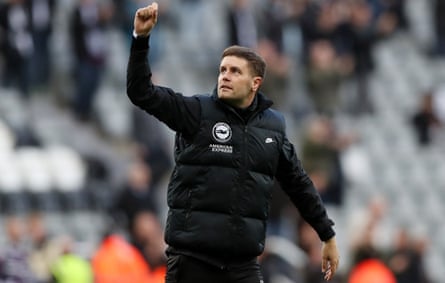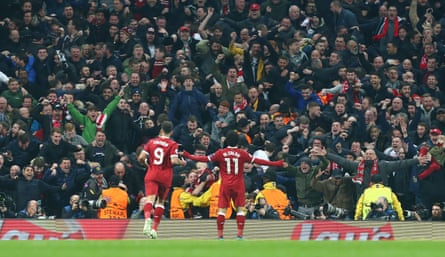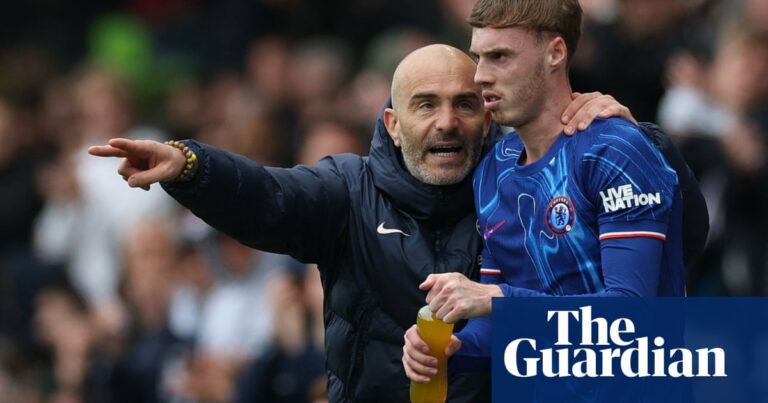It feels as if the days of sacking a manager for a run of defeats then scrolling through the Filofax to find numbers for Big Sam, Big Mick, Massive Moyesy or Huge Harry are coming to an end. There will always be a time and place for managerial heritage but clubs are increasingly mining statistics to help find the best fit for their strategy, players and even brand.
In the Premier League there are no job adverts and applications will not be accepted. Instead the search will start long before the paperwork for the latest P45 begins.
Succession planning is key: knowing the top three choices to replace the person in the dugout, whether they are moving on to bigger and better things or tending to their petunias. Brighton are often the benchmark, quickly replacing Graham Potter with Roberto De Zerbi and hiring Fabian Hürzeler when the Italian departed in the summer, allowing seamless transitions. Everyone is looking to replicate the process.
“When you look at things like Brentford and Brighton, the reason, in part, that they use data so effectively is not just because they were pretty early movers in the space and they have smart people there, it’s because the whole club is aligned to work along that principle,” says Alex Stewart of the sports consultancy Analytics FC. “You need to make sure that all of the relevant stakeholders, which is usually the CEO, the sporting director and the owner, want the same thing.”
Analytics FC is one of a number of companies who provide advice to clubs and associations making appointments. Getting the wrong manager is a costly business: if things do not work out, compensation to sack them can run into the millions. Previously a lengthy CV was all that was required for a manager, hence the same people popping up in many different jobs. Football spent a long time treating itself solely like a sport but it is a multibillion-pound industry and needs to be run as such. In the corporate world the majority of chief executives and financial officers are headhunted by experts and football is catching up.
Well-run clubs have a philosophy running down from the top, dictated by a director of football or equivalent. There is a design of what a club wants to be, helping them understand the process required in the long term and ending the churn of managers with different playing styles that can be unsuited to a squad not recruited for their needs.
Sporting directors or consultants will create a matrix of requirements as they scour for potential candidates to fill a vacancy and will look from Albania to Zambia for coaches who could fit the bill. Studying the data on xG (expected goals) and xG against, for example, can be a good indicator of whether a manager is getting more out of a team than their predecessor. Another key indicator is whether a coach can affect a match by changing tactics or making a substitution, but the spread of stats that can dictate a recruitment process is almost infinite.

“We worked with a club who were cognisant that they had a relatively low transfer budget, so they were interested in potentially having a coach who had access to other regions in terms of scouting knowledge because that maybe would allow them to get players from that region less expensively, or the manager might bring good contacts with them,” Stewart says. “Those sorts of things are all part of the assessment, and we’ll build those in if they’re required.”
At the very top, metrics are used to compare squad value with points earned. The clubs who pay the most on transfers and wages should be first in the league and find coaches who are outperforming based on the relevant data.
These concepts are not faultless but are a good indicator of what a coach has achieved. It may surprise some that even though Pep Guardiola manages a Manchester City squad worth about £1.2bn, he still overachieves based on points accrued each season.
after newsletter promotion
A manager cannot live on stats alone. Man-management is another important concept and for this a sporting director will move away from the numbers and get on the phone to find former players and coaches who have worked with someone under consideration. It still takes plenty of legwork in the background to ascertain who lands perfectly in the middle of the Venn diagram.
The modern manager does not only produce a team to play twice a week but has media commitments. Handling of the press is another key aspect that a sporting director will review, poring over how a manager handles questions from journalists, whether they look nervous or overthink things when the microphone is in front of them and the extent to which words, phrases and cliches are repeated.
These are qualities that cannot be seen on a spreadsheet. Statistics act as a guide and those in charge can use the numbers but cannot hide behind them if something goes wrong. This is not a video game, it is real life and decisions have consequences, but at least more clubs are giving themselves the best chance of getting them right.
-
Do you have an opinion on the issues raised in this article? If you would like to submit a response of up to 300 words by email to be considered for publication in our letters section, please click here.
Source: theguardian.com


















